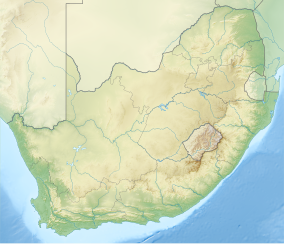Addo Elephant Park
| Addo Elephant National Park | |
|---|---|
|
IUCN category II (national park)
|
|

Bull elephant at Addo
|
|
| Location | Eastern Cape, South Africa |
| Nearest city | Port Elizabeth |
| Coordinates | 33°26′46″S 25°44′45″E / 33.44611°S 25.74583°ECoordinates: 33°26′46″S 25°44′45″E / 33.44611°S 25.74583°E |
| Area | 1,640 km2 (630 sq mi) |
| Established | 1931 |
| Governing body | South African National Parks |
| www |
|
Addo Elephant National Park is a diverse wildlife conservation park situated close to Port Elizabeth in South Africa and is one of the country's 19 national parks. It currently ranks third in size after Kruger National Park and the Kgalagadi Transfrontier Park.
The original section of the park was founded in 1931, in part due to the efforts of Sydney Skaife, in order to provide a sanctuary for the eleven remaining elephants in the area. The park has proved to be very successful and currently houses more than 600 elephants and a large number of other mammals.
The original park has subsequently been expanded to include the Woody Cape Nature Reserve that extends from the Sundays River mouth towards Alexandria and a marine reserve, which includes St. Croix Island and Bird Island, both important breeding habitat for gannets and penguins, not to mention a large variety of other marine life. Bird Island is home to the world's largest breeding colony of gannets - about 120,000 birds - and also hosts the second largest breeding colony of African penguins, the largest breeding colony being St. Croix island. These marine assets form part of the plan to expand the 1,640 km² Addo National Elephant Park into the 3,600 km² Greater Addo Elephant National Park.
The expansion will mean not only that the park contains five of South Africa's seven major vegetation zones (biomes), but also that it will be the only park in the world to house Africa's "Big 7" (elephant, rhinoceros, lion, buffalo, leopard, whale and great white shark) in their natural habitat.
...
Wikipedia

